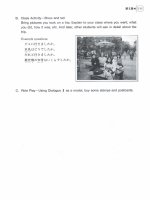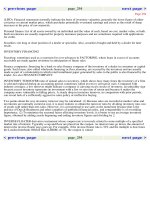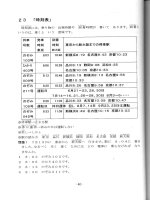gre math review phần 5 docx
Bạn đang xem bản rút gọn của tài liệu. Xem và tải ngay bản đầy đủ của tài liệu tại đây (342.32 KB, 11 trang )
A tangent to a circle is a line that has exactly one point in common with the
circle. A radius with its endpoint at the point of tangency is perpendicular to the
tangent line. The converse is also true.
If each vertex of a polygon lies on a circle, then the polygon is inscribed
in the circle, or equivalently, the circle is circumscribed about the polygon.
Triangle RST below is inscribed in the circle with center O.
If each side of a polygon is tangent to a given circle, then the polygon is
circumscribed about the circle, or equivalently, the circle is inscribed in the
polygon. In the figure below, quadrilateral ABCD is circumscribed about the
circle with center O.
Two or more circles with the same center are called concentric circles.
44
For more material and information, please visit Tai Lieu Du Hoc at www.tailieuduhoc.org
3.6 Three-Dimensional Figures
Basic three-dimensional figures include rectangular solids, cubes, cylinders,
spheres, pyramids, and cones. In this section, we look at some properties of
rectangular solids and right circular cylinders.
(a) A rectangular solid has six rectangular surfaces called faces (see figure
below). Each line segment shown is called an edge (there are 12 edges),
and each point at which the edges meet is called a vertex (there are
8 vertices). The dimensions of a rectangular solid are length
(),l
width (w), and height (h).
A rectangular solid with
l ==wh is called a cube. The volume V of
a rectangular solid is the product of the three dimensions,
V
=l
wh
.
The surface area A of a rectangular solid is the sum of the areas of the
six faces, or
A
=
+
+2( ).whwhll
For example, if a rectangular solid has length 8.5, width 5, and height 10,
then its volume is
V
==(8. )(
)(
),55
10
425
and its surface area is
A
=++=25 5 5
10
510 355[( )(8. ) (8.
)(
)()()] .
45
For more material and information, please visit Tai Lieu Du Hoc at www.tailieuduhoc.org
(b) A right circular cylinder is shown in the figure below. Its bases are
circles with equal radii and centers P and Q, respectively, and its height
PQ is perpendicular to both bases.
The volume V of a right circular cylinder with a base radius r and
height h is the area of the base multiplied by the height, or
V
=
r
h
2
.
The surface area A of a right circular cylinder is the sum of the two
base areas and the area of the curved surface, or
Ar rh=+22
2
38
.
For example, if a right circular cylinder has a base radius of 3 and a
height of 6.5, then its volume is
V ==()(.) . ,365 585
2
and its surface area is
A =+ =()( )() ()( )()(.) .23 236557
2
46
For more material and information, please visit Tai Lieu Du Hoc at www.tailieuduhoc.org
GEOMETRY EXERCISES
(Answers on page 50)
1. Lines
l and m below are parallel. Find the values of x and y.
2. In the figure below,
AC
BC
=
. Find the values of x and y.
3. In the figure below, what relationship must hold among angle measures x,
y, and z ?
4. What is the sum of the measures of the interior angles of a decagon (10-sided
polygon) ?
5. If the polygon in #4 is regular, what is the measure of each interior angle?
6. The lengths of two sides of an isosceles triangle are 15 and 22, respectively.
What are the possible values of the perimeter?
47
For more material and information, please visit Tai Lieu Du Hoc at www.tailieuduhoc.org
7. In rectangle ABDE below,
A
B
BC
==57,, and CD
=
3. Find the
(a) area of ABDE
(b) area of triangle BCF
(c) length of AD
(d) perimeter of ABDE
8. In parallelogram ABCD below, find the
(a) area of ABCD
(b) perimeter of ABCD
(c) length of diagonal AC
9. The circle with center O below has radius 4. Find the
(a) circumference
(b) length of arc ABC
(c) area of the shaded region
48
For more material and information, please visit Tai Lieu Du Hoc at www.tailieuduhoc.org
10. The figure below shows two concentric circles each with center O. If the
larger circle has radius 12 and the smaller circle has radius 8, find the
(a) circumference of the larger circle
(b) area of the smaller circle
(c) area of the shaded region
11. For the rectangular solid below, find the
(a) surface area
(b) length of diagonal AB
49
For more material and information, please visit Tai Lieu Du Hoc at www.tailieuduhoc.org
ANSWERS TO GEOMETRY EXERCISES
1.
x
y
==57 138,
2.
x
y
==70 125,
3.
z
x
y
=+
4. 1,440
5. 144
6. 52 or 59
7. (a) 50 (c)
55
(b) 17.5 (d) 30
8. (a) 48 (c)
229
(b)
24 4 5+
9. (a)
8 (c)
16
9
(b)
8
9
10. (a)
24 (c) 80
(b)
64
11. (a) 208
(b)
317
50
For more material and information, please visit Tai Lieu Du Hoc at www.tailieuduhoc.org
DATA ANALYSIS
4.1 Measures of Central Location
Two common measures of central location, often called “average,” for a
discrete set of numerical values or measurements are the arithmetic mean and
the median.
The average (arithmetic mean) of n values is defined as the sum of the
n values divided by n. For example, the arithmetic mean of the values 5, 8,
8, 14, 15, and 10 is
60 6 10
=
.
If we order the n values from least to greatest, the median is defined as the
middle value if n is odd and the sum of the two middle values divided by 2 if
n is even. In the example above,
n = 6, which is even. Ordered from least to
greatest, the values are 5, 8, 8, 10, 14, and 15. Therefore, the median is
810
2
9
+
= .
Note that for the same set of values, the arithmetic mean and the median need
not be equal, although they could be. For example, the set of values 10, 20, 30,
40, and 50 has arithmetic mean = median = 30.
Another measure of central location is called the mode, which is defined
as the most frequently occurring value. For the six measurements above, the
mode is 8.
4.2 Measures of Dispersion
Measures of dispersion, or spread, for a discrete set of numerical values or
measurements take many forms in data analyses. The simplest measure of disper-
sion is called the range, which is defined as the greatest measurement minus the
least measurement. So, in the example in 4.1 above, the range for the six values
is 15 minus 5, or 10.
Since the range is affected by only the two most extreme values in the set
of measurements, other measures of dispersion have been developed that are
affected by every measurement. The most commonly used of these other
measures is called the standard deviation. The value of the standard deviation for
a set of n measurements can be calculated by (1) first calculating the arithmetic
mean, (2) finding the difference between that mean and each measurement,
(3) squaring each of the differences, (4) summing the squared values, (5) dividing
the sum by n, and finally (6) taking the nonnegative square root of the quotient.
The following demonstrates this calculation for the example used in 4.1.
51
For more material and information, please visit Tai Lieu Du Hoc at www.tailieuduhoc.org
x
x -10
()x -10
2
5
−
5
25
8
−
2
4
8
−
2
4
10 0 0
14 4 16
15 5 25
74
standard deviation
=
74
6
35.
The standard deviation can be roughly interpreted as the average distance
from the arithmetic mean for the n measurements. The standard deviation cannot
be negative, and when two sets of measurements are compared, the one with the
larger dispersion will have the larger standard deviation.
4.3 Frequency Distributions
For some sets of measurements, it is more convenient and informative to
display the measurements in a frequency distribution. For example, the following
values could represent the number of dependent children in each of 25 families
living on a particular street.
1, 2, 0, 4, 1, 3, 3, 1, 2, 0, 4, 5, 2,
3, 2, 3, 2, 4, 1, 2, 3, 0, 2, 3, 1
These data can be grouped into a frequency distribution by listing each different
value (x) and the frequency ( f ) of occurrence for each value.
Frequency Distribution
x f
0 3
1 5
2 7
3 6
4 3
5 1
Total 25
52
For more material and information, please visit Tai Lieu Du Hoc at www.tailieuduhoc.org
The frequency distribution format not only provides a quick summary of the
data, but it also simplifies the calculations of the central location and dispersion
measures. For these data, the x’s can be summed by multiplying each x by its
frequency and then adding the products. So, the arithmetic mean is
( )( ) ( )( ) ( )( ( )( ) ( )( ) ( )( )
.
03 15 27) 3
6
43 51
25
216
++ + + +
=
The median is the middle (13th) x value in order of size. The f values show
that the 13th x value must be a 2. The range is 5 minus 0, or 5. The standard
deviation can also be calculated more easily from a frequency distribution,
although in practice it is likely that a programmable calculator would be
used to calculate both the mean and the standard deviation directly from the
25 measurements.
4.4 Counting
Some definitions and principles basic to counting are:
(a) If one task has n possible outcomes and a second task has m possible
outcomes, then the joint occurrence of the two tasks has (n)(m) possible
outcomes. For example, if Town A and Town B are joined by
3 different roads, and Town B and Town C are joined by 4 different
roads, then the number of different routes from Town A to Town C
through B is (3)(4), or 12. Each time a coin is flipped, there are
2 possible outcomes: heads or tails. Therefore, if a coin is flipped
4 times, then the number of possible outcomes is (2)(2)(2)(2), or 16.
(b) For any integer n greater than 1, the symbol n!, pronounced
“n factorial,” is defined as the product of all positive integers
less than or equal to n. Also, 0! = 1! = 1. Therefore,
0! = 1
1! = 1
2! = (2)(1) = 2
3! = (3)(2)(1) = 6
4! = (4)(3)(2)(1) = 24
and so on.
(c) The number of ways that n objects can be ordered is n!. For example,
the number of ways that the letters A, B, and C can be ordered is 3!,
or 6. The six orders are
ABC, ACB, BAC, BCA, CAB, and CBA
53
For more material and information, please visit Tai Lieu Du Hoc at www.tailieuduhoc.org
(d) The number of different subsets of r objects that can be selected from
n objects
(r n) , without regard to the order of selection, is
n
nrr
!
()!!
.
-
For example, the number of different committees of 3 people that can
be selected from 5 people is
5
533
5
23
120
26
10
!
()!!
!
!! ()()
.
-
== =
These 10 subsets are called combinations of 5 objects selected 3 at
a time.
4.5 Probability
Everyday there are occasions in which decisions must be made in the face of
uncertainty. The decision-making process often involves the selection of a course
of action based on an analysis of possible outcomes. For situations in which the
possible outcomes are all equally likely, the probability that an event E occurs,
represented by “P(E)”, can be defined as
PE
E
() .=
The number of outcomes involvi
ng the occ
urrence o
f
The total number of possible outcomes
For example, if a committee of 11 students consists of 2 seniors, 5 juniors, and
4 sophomores, and one student is to be selected at random to chair the committee,
then the probability that the student selected will be a senior is
2
11
.
In general, “P(E)” can be thought of as a number assigned to an event
E which expresses the likelihood that E occurs. If E cannot occur, then
P
E
()= ,0 and if E must occur, then P
E
()=.1 If the occurrence of E is
uncertain, then
01<<P
E
() .
The probability that event E does NOT occur
is
1 - P
E
(). For example, if the probability is 0.75 that it will rain tomorrow,
then the probability that it will not rain tomorrow is
1075- ., or 0.25.
The probability that events E and F both occur can be represented by
P(E and F)*, and the probability that at least one of the two events occurs can
be represented by P(E or F)**. One of the fundamental relationships among
probabilities is called the Addition Law:
P
E
F
P
E
P
F
P
E
F
( or ) = ( ) + ( ( and ).) -
_________
*Many texts use P
E
F
().¬
**Many texts use P
E
F
().
54
For more material and information, please visit Tai Lieu Du Hoc at www.tailieuduhoc.org









